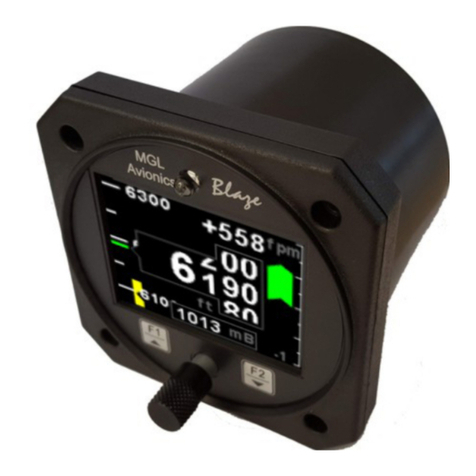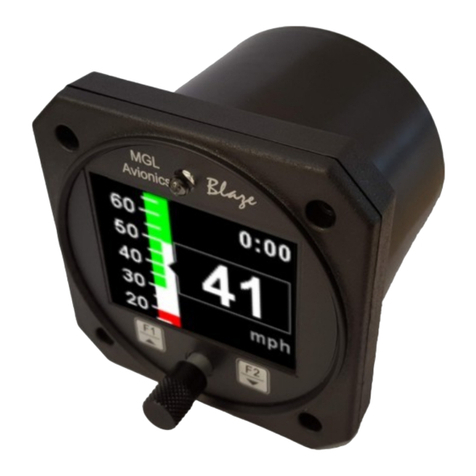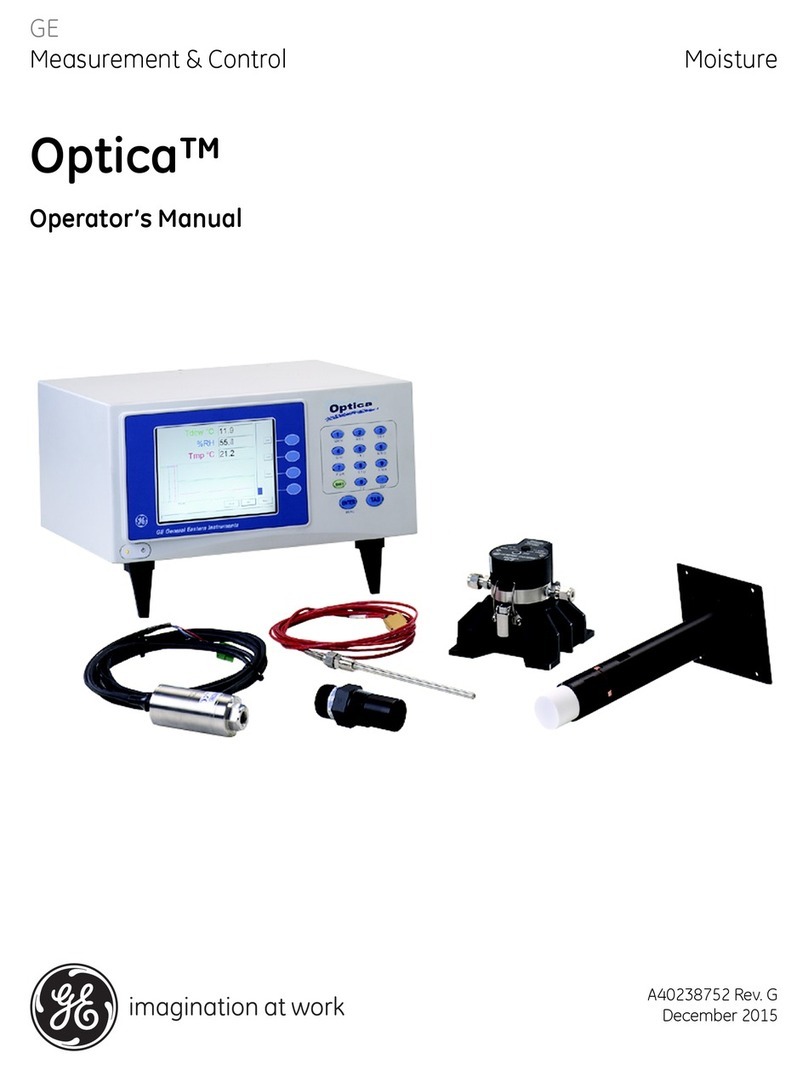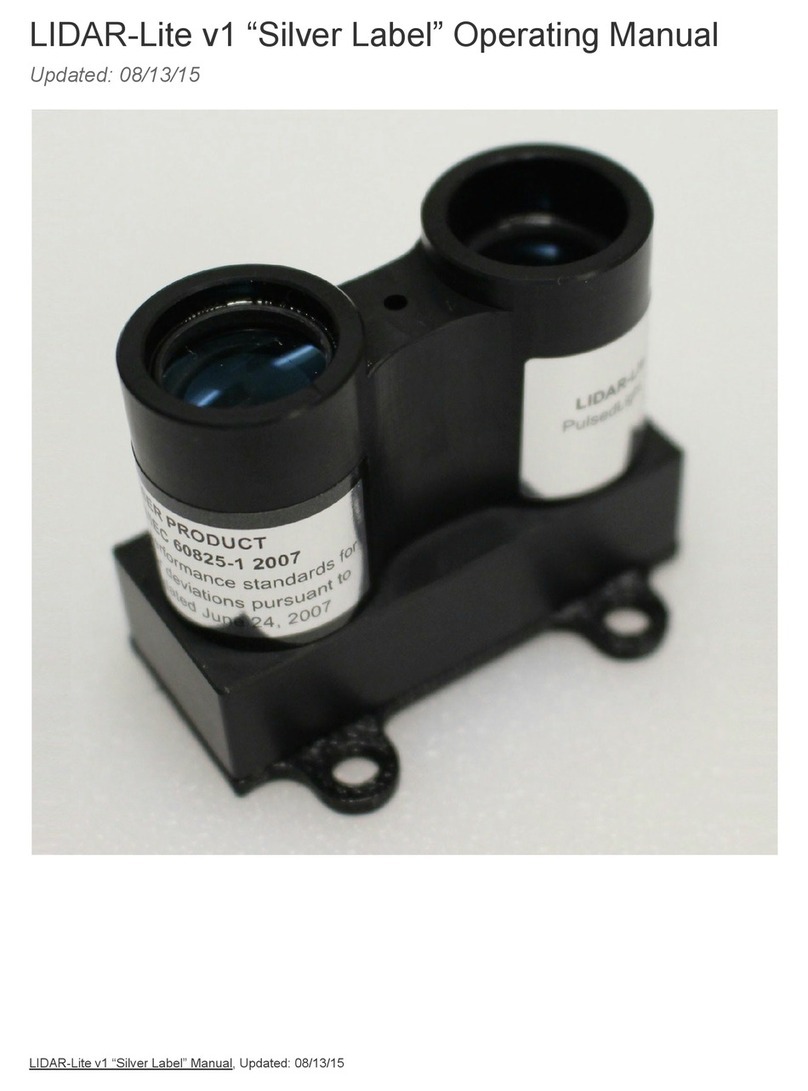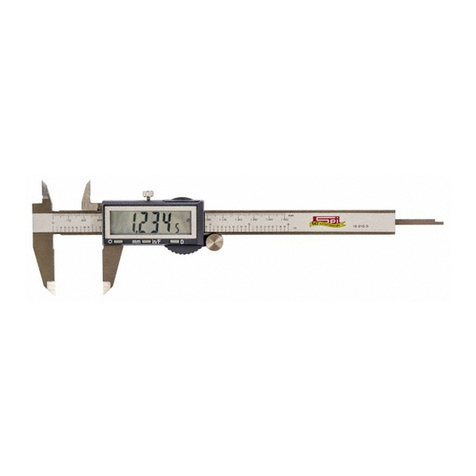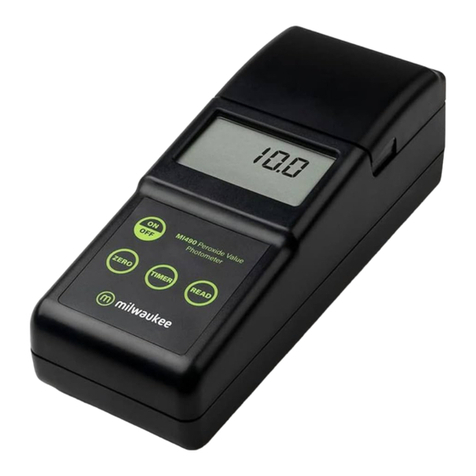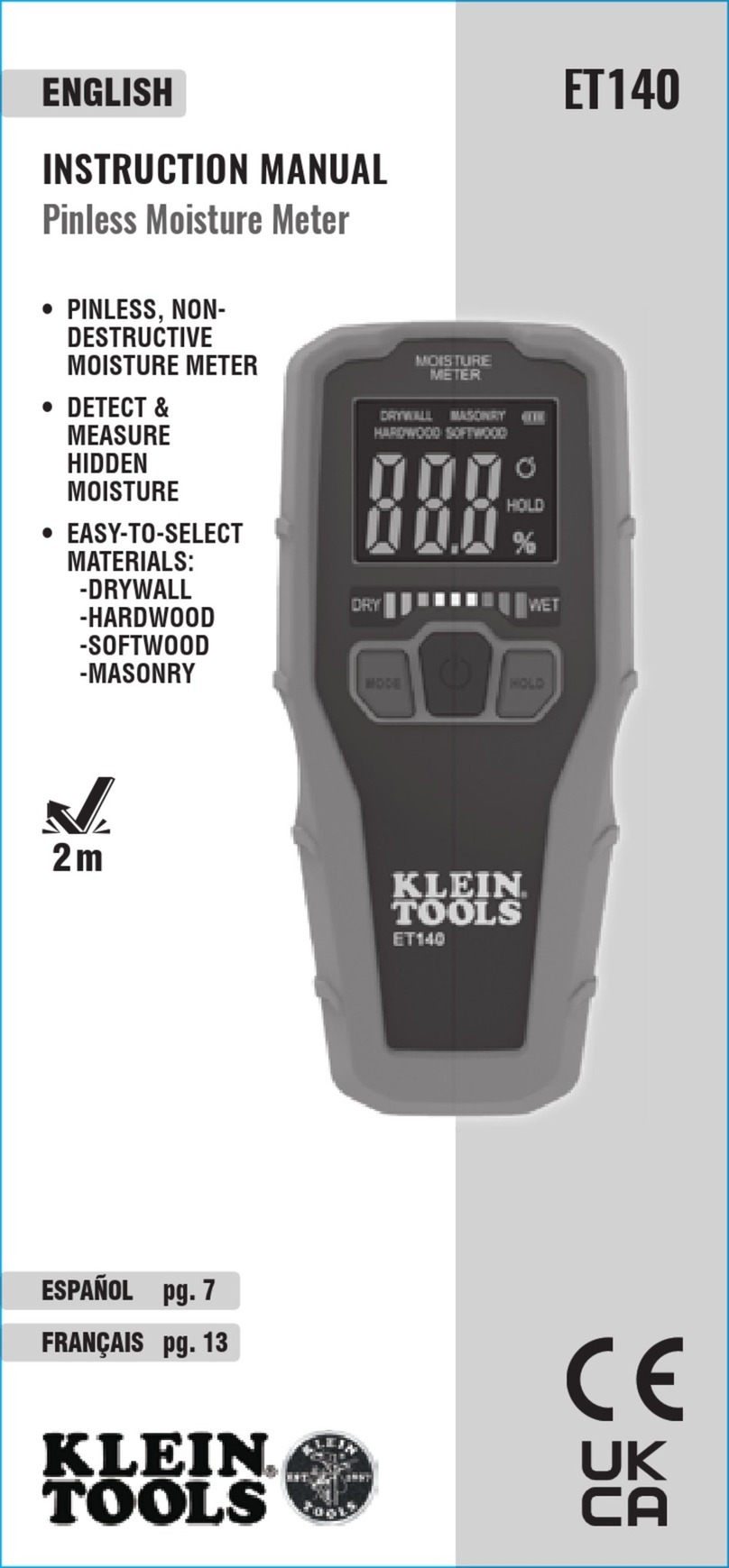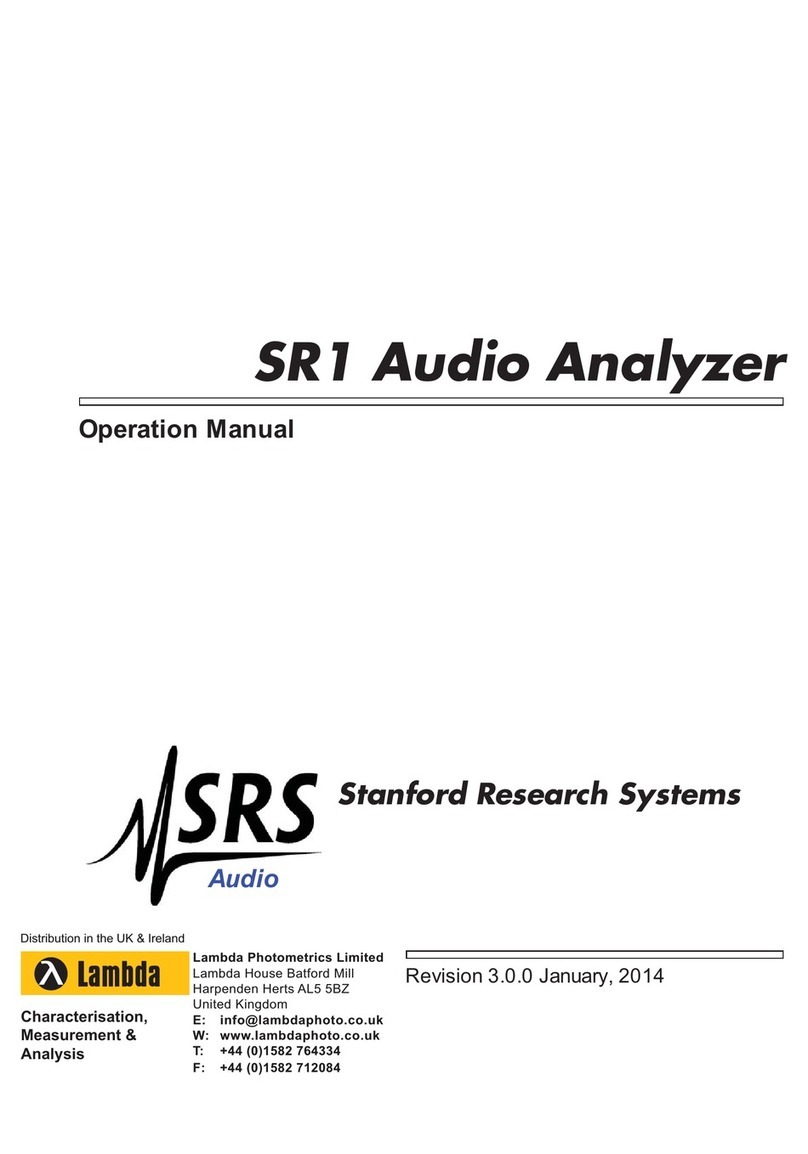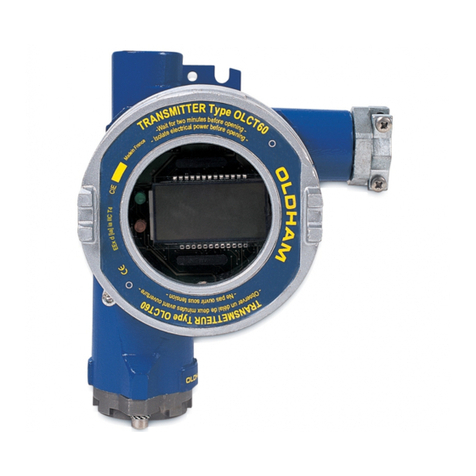Blaze ASV-2 User manual

Introduction
The ASV-2 is a 3 1/8” (80mm) sunlight readable encoding altimeter airspeed and wide range vertical speed indicator.
The altimeter contains an internal high accuracy 24 bit digital altitude sensor which calculates altitude from -1500 ft up to
a maximum of 35000 ft. The ASV-2 outputs various formatted RS232 serial data protocols compatible with serial input
transponders such as that from Garmin Magellan Northstar Trimble Microair etc. The altimeter can display altitude in
feet or meters and local pressure can be set in millibars or inches of mercury
The VSI indicator can be displayed in either feet/minute (ft/min) or meters/second (m/s). The VSI can be calibrated by the
user once the instrument has been installed in the aircraft.
Airspeed is based on the pressure generated by a pitot tube system and a static port is provided as well for use by high
speed aircraft. The ASV-2 can measure airspeed from 20mph to 250mph (Version 1) 20mph to 350mph (Version 2) and
20mph to 320mph for the ASV-2HS (High Speed version). All are well suited to slower aircraft due to very good sensitivity
and linearity at low air speeds. Airspeed can be indicated in statute miles per hour (mph) kilometers per hour (km/h) or
nautical miles per hour (kts). The ASV-2 also provides a programmable Vs and Vne airspeed alarm output. ASI sensitivity
can be calibrated by the user to cater for errors caused by pitot tube placement.
In addition the ASV-2 provides an encoder test function flight timer since takeoff and records the maximum airspeed
reached. The ASV-2 provides a parallel Gillham code interface when used in conjunction with the MGL Avionics CNV-
ALT.
Please note that the ASV-2 Version 2 replaces both the ASV-2 Version 1 and the ASV-2HS (High speed) unit.
Blaze ASV-2
Alti eter, Airspeed (ASI) and Vertical
Speed Indicator (VSI)
Operating Manual – English 1.04

Blaze ASV-2 Operating Manual Page 2
1 Features
•Large 2.6” high resolution 320x240, IPS (fully viewa le in all directions), sunlight reada le color LCD
display
• An internal high accuracy 24 bit digital altitude sensor calculates altitude fro –1500 ft up to a axi u
of 35000 ft (-457 to 10668 )
• The ASV-2 outputs various for atted RS232 serial data protocols co patible with serial input
transponders such as that fro Gar in, Magellan, Northstar, Tri ble, Microair etc.
• Provides a parallel Gillha code interface for transponders when used in co bination with the MGL
Avionics CNV-ALT
• Built in encoder test function
• The alti eter can display altitude in feet or eters
• Local pressure can be set in illibars or inches of ercury
• Contains a wide range VSI indicator fro +/-20 ft/ in to as high as +/-10000 ft/ in
• VSI units can be in feet/ inute (ft/ in) or in eters/second ( /s)
• The ASV-2 easures airspeed fro 20 ph to 250 ph (Version 1)
• The ASV-2 easures airspeed fro 20 ph to 350 ph (Version 2)
• The ASV-2HS (High Speed version) easures airspeed fro 20 ph to 320 ph
• Both units are well suited to slow aircraft due to very good sensitivity and linearity at low air speeds
• Includes a flight ti er since takeoff
• Airspeed units can be set to iles per hour ( ph), kilo eter per hour (k /h) or nautical iles per hour
(kts)
• Contains a progra able Vs and Vne airspeed alar output
• Records axi u airspeed reached in per anent e ory
• Includes a RS232 serial output for interfacing to external equip ent e.g dataloggers etc.
• Standard 3 1/8” (80 ) aircraft enclosure (can be front or rear ounted)
• The LED backlight can auto atically adjust to the a bient light, or it can be anually adjusted in the
enu syste
• Rotary control plus 2 independent buttons for easy enu navigation and user input
• Wide input supply voltage range of 8 to 30V DC
• 1 year li ited warranty

Blaze ASV-2 Operating Manual Page 3
2 Layout
3 Main Display
F2 / Down Button:
Menu system: Softkey button
Normal display: Press to view the
Timers and Max Values display
Sunlight readable color graphic display:
The backlight can automatically adjust
to the ambient light or it can be manually
adjusted in the menu system
Rotary Control (Up/Down) & Enter Button:
Press the rotary control during the normal display screens to access the menu system. Rotate anti/clockwise
for up/down menu scrolling. Rotate the rotary control during the normal display mode to adjust the local
pressure. Local pressure can be set in either mB or in “Hg.
F1 / Up Button:
Menu system: Softkey button
Normal Display: Start / Stop the
flight timer (Manual flight only)
3 1/8” (80mm) enclosure.
Can be front or rear mounted
VSI scale indication
VS I (Vertical Speed Indication)
VSI unit
Altitude value
Local pressure readout (Either in mB or in “HG)
VSI value
Altitude unit
Airspeed unit
Airspeed value
Ambient light sensor

Blaze ASV-2 Operating Manual Page 4
3.1 Start / Stop flight display
Press the F1/Up button during the normal display mode
to manually start/stop a flight. This key is only active if
the ASV-2 is setup to select the manual flight option
under the “TIMERS” setup menu.
3.2 Ti ers display
This display can be accessed by pressing the F2/Down button during the normal display
mode.
3.3 Maxi u Airspeed display
This display can be accessed by pressing the F2/Down button during the normal display
mode. Press the F1/Up button when the max values display is showing to reset the
maximum values to the current airspeed.
Note: The axi u airspeed is stored in non-volatile
e ory and is recalled on power-up.

Blaze ASV-2 Operating Manual Page 5
4 Menu Syste
Press the rotary control button during the normal display mode to enter the menu system. Use the rotary control to
navigate through the menu system.
4.1 Exiting the enu syste
Press the F1/Up button to exit the menu system when the “EXIT” soft key is shown. All changes made during navigation
of the menu system will be saved in non-volatile memory upon exiting. The instrument will not save any changes if you
remove power before exiting the menu system.

Blaze ASV-2 Operating Manual Page 6
4.2 Flight Ti er
View Flight Log:
Use the rotary control to view the next flight log entry.
Erase Flight Log:
Use this function to erase the flight log stored in the ASV-2.
FLIGHT:
Select whether you want the ASV-2 to automatically detect a flight or whether the pilot must press the F1/Up button to
start/stop a flight. We recommend you select automatic flight detection.
T/O AIRSPEED:
This menu option is only shown if the “DETECT” flight mode is selected. Enter the takeoff airspeed threshold that you
want the flight timer to start incrementing.

Blaze ASV-2 Operating Manual Page 7
4.3 ALT Setup (Altitude Setup)
Altitude U it:
Select if you want the altitude displayed in ft (feet) or m (meters).
Pressure U it:
Select if you want the local pressure displayed in mb (millibars) or “Hg (inches of mercury).
Resolutio :
Select the resolution of the altitude value a selection of 1 10 25 or 100 ft or m can be selected.
Positio :
Select whether you want the altitude display on the top or on the bottom of the main display.
ALT Calibrate
This section allows for the calibration and fine tweaking of the altitude value. Before you begin ensure that your calibrated
and certified reference is set to the local pressure of 1013.25mB (29.92”Hg). The ALT-5 altitude value in ft (referenced to
1013.25mB (29.92”Hg)) is displayed in the top right hand corner of the display. All calibration must be done in feet.
The combined adjustments cater for both the altitude sensors offset and gain. Only start the calibration sequence once
the instrument has been running for a minimum of 10 minutes.
Start the altitude calibration with the “CAL FACTOR” and make sure the “CAL GAIN” value is set to 100.00%.

Blaze ASV-2 Operating Manual Page 8
Cal Factor:
This is the pressure sensor offset in 0.1mB increments. Adjust your static pressure to be close to sea level pressure. The
exact altitude is not important and can be up to several hundred feet. Adjust the calibration factor so the altitude readout
in the top right hand corner of the display agrees with your pitot static test set.
Cal Gai :
Once you are satisfied that the low level altitude “CAL FACTOR” is correct apply a static pressure that will result in an
altitude between 20000 and 30000 ft. Adjust the “CAL GAIN” until the altitude readout in the top right hand corner of the
display agrees with your pitot static test set
NOTE: Adjusting the “CAL GAIN” also changes the low level altitude calibration achieved when adjusting the “CAL
FACTOR”. Please recheck your low level altitude calibration and adjust if necessary. Recheck your altitude readout at the
higher altitude and if needed slightly adjust the “CAL GAIN” again. Repeat the process until you are satisfied with both
the “CAL FACTOR” altitude and the “CAL GAIN” altitude.
Serial Out:
Select “ON” to enable the RS232 serial altitude output. This formatted serial RS232 message can be directly interfaced to
various RS232 serial input transponders. If a parallel Gillham output is required then a CNV-ALT can be purchased from
your MGL Avionics distributor to convert the RS232 output to a parallel Gillham output.
Prot:
Select the protocol of the serial RS232 output message. The protocol can be selected between GARMIN AT Magellan
Northstar / Garmin Trimble / Garmin MGL Avionics and Microair UAV. Please note that the baud rate is automatically
adjusted according to which protocol is selected. The output format is as follows. The message contains the current
pressure altitude with a fixed reference to 1013.25mB (29.92 inches mercury). All protocols use 8 databits no parity and
1 stop bit. The message is outputted once a second.
Protocol Baud
Rate
Message for at Exa ple
Garmin AT 1200 #AL space +/- five altitude digits right
justified zero padded T+25 checksum
carriage return
The checksum is a simple modulo 256 sum
of the binary values of the individual
characters. The checksum is sent as two
characters in hexadecimal format
#AL +02372T+25DF[CR]
Magellan 1200 #MGL +/- five altitude digits right justified
zero padded T+25 checksum carriage
return
The checksum is a simple modulo 256 sum
of the binary values of the individual
characters. The checksum is sent as two
characters in hexadecimal format
$MGL+02372T+2513[CR]
Northstar
Garmin
4800 ALT space five altitude digits right justified
zero padded carriage return
ALT 02372[CR]
Trimble
Garmin
9600 ALT space five altitude digits right justified
zero padded carriage return
ALT 02372[CR]
MGL Avionics 9600 ALT +/- five altitude digits right justified
zero padded 1013.25mB (29.92”Hg)
referenced C +/- five altitude digits right
justified zero padded (corrected to local
pressure) L local pressure setting in
millibars +/- four digit VSI reading right
justified zero padded in ft/min X
checksum carriage return
ALT+02372C+02372L1013+0000XCA[
CR]

Blaze ASV-2 Operating Manual Page 9
The checksum is a simple modulo 256 sum
of the binary values of the individual
characters. The checksum is sent as two
characters in hexadecimal format
Microair UAV 9600 STX a = five altitude digits right justified
zero padded ETX
[STX]a=02372[ETX]
Infiniteq 57600 See Infiniteq protocol format below
STX=0x02
ETX=0x03
CR=0x0D
Infiniteq protocol for at:
STX, Address, Message type, Length, Data payload, Checksu , ETX
STX: Start of text (0x02)
Address: unsigned char (8bit) (0x01)
Message Type: unsigned char (8bit) (0x06)
Length: unsigned char (8bit) Length of the data payload (does not include the STX Address message type checksum or
ETX) (0x08)
Data payload:
Altitude: Signed Long (32 bit) Altitude in feet (Referenced to 1013.25mB)
Vertical Speed: Signed Int (16 bit) Vertical Speed in ft/min
Airspeed: Unsigned Int (16 bit) Airspeed in mph
Checksum: unsigned char (8bit) XOR of all bytes starting from the unit address to the end of the data payload. The
checksum is seeded with 0xa5. (does not include the STX or ETX)
ETX: End of text (0x03)

Blaze ASV-2 Operating Manual Page 10
Test Alt E coder:
This is a handy function to test the ASV-2 transponder interface once the installation has been completed. The serial
output will output specific altitudes which can then can be used to test the serial RS232 output and the parallel gillham
output if using a CNV-ALT converter. The ASV-2 will resume the normal output of the indicated altitude upon exiting the
test function.
The following codes are outputted:
Altitude D4 A1 A2 A4 B1 B2 B4 C1 C2 C4
-1000ft 0 0 0 0 0 0 0 0 1 0
-900ft 0 0 0 0 0 0 0 1 1 0
-700ft 0 0 0 0 0 0 1 1 0 0
-400ft 0 0 0 0 0 0 1 0 1 1
-200ft 0 0 0 0 0 1 1 0 0 1
800ft 0 0 0 0 1 1 0 0 0 1
2800ft 0 0 0 1 1 0 0 0 0 1
6800ft 0 0 1 1 0 0 0 0 0 1
14800ft 0 1 1 0 0 0 0 0 0 1
30800ft 1 1 0 0 0 0 0 0 0 1
Each altitude reporting code line must be tested for integrity of connection if at any time the aircraft connections to the
transponder or altitude data source have been removed and reconnected. Integrity of the connections may be verified by
performing a test of mode C function of the transponder system.
Warning: Do not use this function while in flight as incorrect altitude information will be sent to
the transponder.

Blaze ASV-2 Operating Manual Page 11
4.4 VSI Setup (Vertical Speed Indicator Setup)
VSI Display:
Select if you want the VSI to be displayed.
VSI U it:
Select if you want the VSI to be displayed in "ft/min" (feet/minute) or "m/s" (meters/second).
Scale:
Select the VSI scale most suited for your aircraft.
VSI Cal:
This is a function that is used to calibrate your VSI to read exact rates of climb or decent. This function works as a
percentage of initial reading. The default setting for this function is 100%. Increasing this value increases the VSI reading
and decreasing the value decreases the reading.
Suggested VSI calibration ethod
After you have installed the instrument perform a calibration flight. This should be done in very calm conditions.
Turbulence and thermal activity will make accurate calibration impossible. Many areas have ideal conditions during early
mornings or late afternoons. Place the instrument in ft/min for ease of calibration. Take your aircraft to a few
thousand feet above ground and start a glide with a low power setting. Take a stopwatch and when the glide is stable
(stable VSI reading) start the stopwatch. Take note of your altimeter reading at the same time. Continue the stable glide
for one minute exactly. After the minute has finished take another reading of your altimeter.
Exa ple:
VSI reading during stable glide: -400 ft/min
Start altitude: 2500 ft.
End altitude: 2050 ft.
In the above example the VSI is under reading by about 12%. Set your VSI calibration to 112% to cancel out the error.

Blaze ASV-2 Operating Manual Page 12
4.5 ASI Setup (Airspeed Setup)
Zero ASI Se sor:
This setup allows your instrument to measure the zero airspeed reading of the airspeed sensor and set a calibration value
internally for this. This is equivalent to some mechanical airspeed indicators that have an adjustment to set the needle to
zero when the aircraft is not moving. You would use this function occasionally if you see an airspeed reading when the
aircraft is at rest. This may be caused by aging of the built in pressure sensor or related electronics. When this function is
performed make sure that there is no air flow into the pitot tube as this would result in an incorrect internal calibration.
ASI U it:
Select if you want the ASI to be displayed in mph (statute miles per hour) km/h (kilometers per hour) or kts (nautical miles
per hour).
ASI Filter:
This function can be used to select the signal filter time constant. Selections are "NONE" “FAST” or “SLOW”. This
selection influences the rate at which your ASI can change its reading. If you have an installation that suffers from strong
turbulence at the pitot tube select “slow”. If you have a very clean airflow in front of the pilot tube you can select “fast”
which will give you a faster response to airspeed changes.

Blaze ASV-2 Operating Manual Page 13
V e Speed: (Max Exceed Speed)
Enter you maximum speed you aircraft should not exceed.
V o Speed: (Max Ma euveri g Speed)
Enter your maximum maneuvering speed.
Vfe Speed: (Max Flap Speed)
Enter the maximum speed that is permissible with the flaps extended.
Vs1 Speed: (Mi Safe Speed, Normal)
Enter your minimum safe speed for normal flight of your aircraft
Vs0 Speed: (Mi Safe Speed, La di g)
Enter your minimum safe speed for landing your aircraft
Vs Alarm:
This enables or disables Vs Alarm.
V e Alarm:
This enables or disables the VNE alarm.
Cal:
During the factory calibration a factor has been determined and entered here that will give you accurate airspeed
provided your pitot tube is not influenced by pressure effects caused by airflow around your airframe. The calibration is
displayed in % of the reading you can increase or decrease the reading if required to help cancel out under or over
reading of the airspeed indicator on your aircraft.
Positio :
Select whether you want the airspeed display on the top or on the bottom of the main display.

Blaze ASV-2 Operating Manual Page 14
4.6 MISC Setup (Miscellaneous Setup)
Backlight:
Select manual or automatic backlight control.
Use the rotary control in manual mode to adjust the backlight brightness.
Allow 3 seconds for the display to adjust to the ambient lighting conditions when using
the automatic backlight mode. The display will set the backlight to the dim setting if the
ambient light is less then the threshold setting alternatively the display will set the
backlight to the bright setting if the ambient light is greater then the threshold setting. The
ambient light received is shown as the ADC value in the top header. Use this value to set
the threshold value.
Security Setup:
Select this menu option if you want to password protect the menu system.
I formatio :
This menu option displays information about the unit.

Blaze ASV-2 Operating Manual Page 15
Default Setti gs:
Select this menu option to reset all the settings to factory defaults.
4.7 Sensor Info
This menu displays information about the altitude and airspeed sensors.
5 Loading factory default settings
Press and hold the F1/Up button and rotary control during power up to load the pre-
programmed factory default settings. The following screen will be displayed:
Factory default settings can also be loaded in the Miscellaneous setup menu.

Blaze ASV-2 Operating Manual Page 16
6 Error Messages
Unit settings CRC error. Load default settings to restore to factory defaults. If the error
message still persists then it could possibly be a non-volatile memory failure in which
case the instrument will then have to be returned to the factory.
Calibration constants CRC error. The instrument could possibly have a non-volatile
memory failure in which case the instrument will then have to be returned to the factory.
Internal flash CRC error. The instrument does a firmware check on the program when
power is applied to the instrument . If the program is corrupt in any way then the internal
flash CRC error will be displayed. Reload the instruments firmware and load default
settings. If the error message still persists then it could possibly be an internal flash
memory failure in which case the instrument will then have to be returned to the factory.
Max Values CRC error. Load default settings to restore to factory defaults. If the error
message still persists then it could possibly be a non-volatile memory failure in which
case the instrument will then have to be returned to the factory.
Altitude sensor error. The instrument could have a faulty altitude sensor in which case
the instrument will then have to be returned to the factory.
Airspeed sensor error. The instrument could have a faulty airspeed sensor in which case
the instrument will then have to be returned to the factory. (Digital airspeed sensor
models only)

Blaze ASV-2 Operating Manual Page 17
7 Specifications
Operating Te perature Range -10ºC to +55ºC (14ºF to 131ºF)
Storage Te perature Range -20ºC to 80ºC (-4ºF to 176ºF)
Hu idity <85% non-condensing
Power Supply 10 to 30Vdc
Current Consu ption Approx. 125mA @ 12V (backlight highest setting) 50mA @12V (backlight
lowest setting)
Display
2.6” 320x240 IPS color LCD display
Minimum 600cd/m2 brightness
Sunlight readable with anti-glare coating
LED Backlight can be set to automatic or can be manually adjusted
Alar Output Open collector transistor switch to ground
Maximum rating 0.25A
Di ensions see Blaze series dimensional drawing
Enclosure 3 1/8” (80mm) ABS black in color front or rear mounting. Flame retardant.
Weight Approx. 160 grams (Instrument excluding cables)
Non-volatile e ory storage 100000 write cycles
Altitude sensor ADC resolution 24 bit
Alti eter range -1500ft to 35 000ft (-457m to 10668m)
Altitude units ft or m
Baro Correction Range (inHg) 28.00 to 31.00 “Hg
Baro Correction Range ( B) 946 to 1050 mb
Pressure units “Hg or mb
VSI range +-20ft/min to +-10000ft/min
VSI units ft/min or m/s
Airspeed ADC resolution
ASV-2 Version 1: 12 bit
ASV-2 Version 2: 24 bit
ASV-2HS: 13.5bit
Airspeed range
ASV-2 Version 1: 20mph to 250mph
ASV-2 Version 2: 20mph to 350mph
ASV-2HS (High Speed version): 20mph to 320mph
Airspeed resolution 1 mph
Measure ent accuracy +/- 2mph
Serial Port RS232 voltage levels
Calibration interval 1 Year
As with any instru ent, regular zeroing is suggested to achieve axi u perfor ance.
8 Operating the alar s
The alarm output can be used to switch an external alarm indicator. The external alarm switch is an open collector
transistor switch to ground with a maximum rating of 0.25A DC. It is possible to wire the alarm contacts of several
Stratomaster instruments in parallel should this be desired. To avoid false activation of the alarms the alarm function is
only active 10 seconds after the instrument has powered up.
9 Fir ware Upgrading
The ASV-2 can be upgraded in the field by connecting the RS232 port to a PC and running the firmware update program.
Note that only the RS232 port can be used to upgrade the fir ware.
Please see the Blaze fir ware upgrading docu ent for ore infor ation.

Blaze ASV-2 Operating Manual Page 18
10 Installation
Connect a pitot tube to the “pressure port” and if required connect the static port.
Connect the static port to a suitable static air pressure line. If you have a slow aircraft or an aircraft where the internal
cabin pressure does not change during flight and is equivalent to the outside air pressure you may find that it is not
required to connect a static port. Most small aircraft such as ultralights or microlights do not require a connection to a
static port. In these cases simply leave the static port open. Ensure however that the static port does not receive
pressurized air due to the forward movement of the aircraft. Be especially critical of your pod or panel if you do not use a
static port. Any build up of a pressure differential due to ram air or suction can lead to large errors of the indicated
airspeed and altitude. Static ports are usually mounted at a strategic position on the rear side of the aircraft fuselage for
faster pressurized aircraft.
The ASV-2 pressure ports take 4mm ID tubing. Use hose clamps to fasten the hose onto the ASV-2 pitot and static ports.
The ASV-2 allows you to calibrate the airspeed reading. This is done under the “AIRSPEED SETUP” menu item. The
main reason for this is to be able to remove errors introduced due to the airflow around your aircraft which may have an
effect on your pitot tube pressure.
10.1 Connection Diagra
The use of an external 1A fuse is recommended. Connect the supply terminals to your aircrafts power supply. The ASV-2
can be used on both 12V and 24V without the use of any pre-regulators. Ensure that the supply voltage will not drop
below 8V during operation as this may result in incorrect readings.

Blaze ASV-2 Operating Manual Page 19
10.2 Pressure Port Di ensions
Version 1 pressure ports (Plastic)
Version 2 pressure ports (Brass)
10.3 Cable connections
Main connector (D15 connector: Unit Fe ale, Cable Male)
D15 Pin Color Function
1 Red 8-30Vdc power via power switch / circuit
breaker and fuse.
2 Black Ground.
3 White/Blue
Stripe
RS232 Trans it data (Fir ware upgrading /
RS232 Altitude output)
4 - RS232 Receive data (Fir ware upgrading)
15 White Alar Output (Open collector)
Inches Milli eters
Min Max Min Max
A0.248 0.278 6.30 7.06
B0.420 0.440 10.67 11.18
C0.182 0.194 4.62 4.93
D0.310 0.330 7.87 8.38
Inches Milli eters
A0.157 4
B0.197 5
C0.63 16
D0.79 20

Blaze ASV-2 Operating Manual Page 20
11 Di ensions
Table of contents
Other Blaze Measuring Instrument manuals
Popular Measuring Instrument manuals by other brands
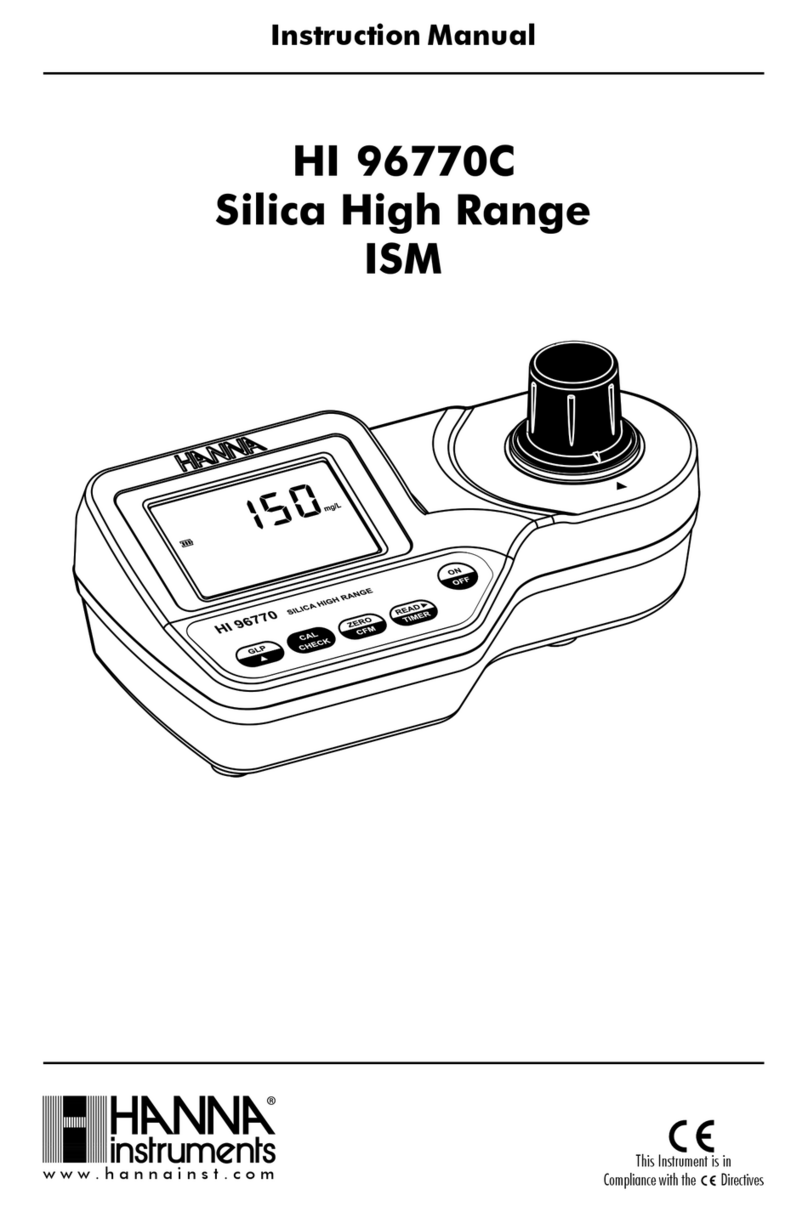
Hanna Instruments
Hanna Instruments HI 96770C instruction manual
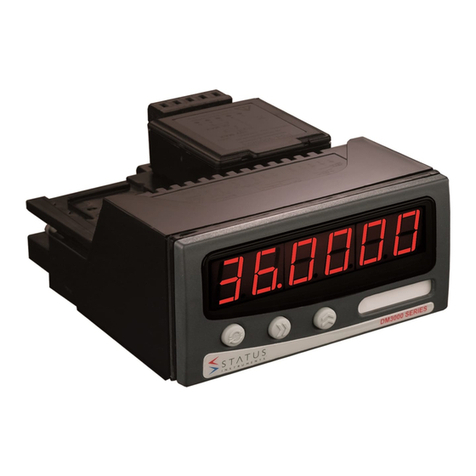
Status Instruments
Status Instruments DM3600A manual

Würth
Würth 0964 764 009 Translation of the original operating instructions
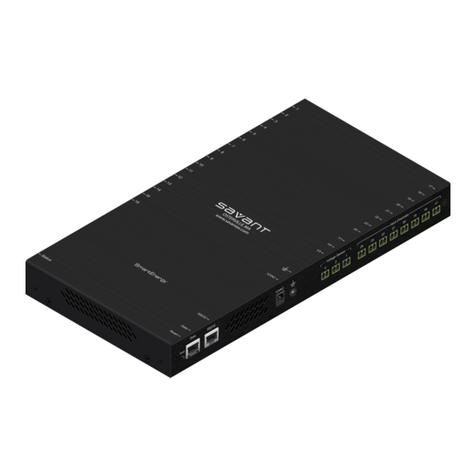
Savant
Savant SmartEnergy SEM-1024 Quick reference guide

LeCroy
LeCroy LSA1000 Operator's manual

Tenmars
Tenmars TM-4001 user manual
